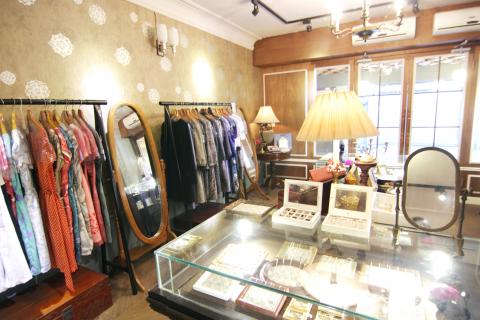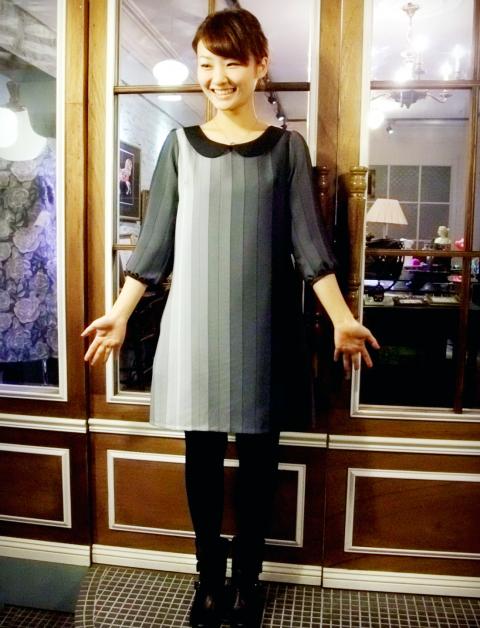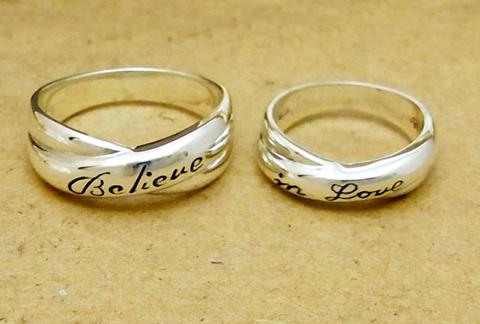When Tsao Hui-chi (曹惠淇) was a teenager, she didn’t get to see her two sisters often.
“I left home to study in middle school, so we really treasured the time we had with each other,” Tsao says.
Now the trio spend plenty of time together as the creators of jewelry and clothing brand Georgia Tsao. Named after Lady Georgie (喬琪姑娘), one of their favorite childhood cartoons, the company specializes in playful sterling silver designs and recently opened a flagship boutique near Shida night market.

Photos: CATHERINE SHU, Taipei times AND courtesy of Georgia Tsao
Tsao Hui-chi, who completed her graduate studies at the Birmingham School of Jewellery in England, is responsible for creating the brand’s jewelry, while her sisters take care of marketing and managing Georgia Tsao’s three stores. Older sister Tsao Hui-chun (曹惠鈞) earned an MBA from the Thunderbird School of Global Management in Arizona, while youngest sister Tsao Chiao-ling (曹巧鈴) has a master’s degree in marketing from the University of Westminster in London.
The Tsao sisters’ parents hoped that their daughters would join them in the family’s health food business, but Tsao Hui-chi had other ideas.
“I had a design degree and I wasn’t really interested in working there. I thought, ‘Why not create a jewelry brand instead?’” she says.

Photos: CATHERINE SHU, Taipei times AND courtesy of Georgia Tsao
With an initial investment from their parents, the sisters launched Georgia Tsao in 2005 and began selling their sterling silver jewelry online and at events like Campo, TK Rock (台客搖滾) and Simple Life Festival (簡單生活節).
Their first piece was a pendant shaped like a Viking helmet with a tiny heart on the crown. The design is now Georgia Tsao’s logo.
“It reflects our brand philosophy. Our target customers are independent, courageous women. I thought, why not make a Viking helmet and place a small heart on it to make it cuter? It symbolizes bravery and love,” Tsao Hui-chi says.

Photos: CATHERINE SHU, Taipei times AND courtesy of Georgia Tsao
In 2008, the sisters opened their first store in Red House’s 16 Workshops (16工房). Two more locations opened earlier this year: a jewelry shop in Banciao Global Mall (板橋環球購物中心) and their flagship boutique.
The latter is decorated with vintage items, including 1960s wooden hangers stamped with the logos of clothing stores that once operated in Yuanlin (員林), a Changhua County township where the sisters’ parents live; refurbished jewelry display cases; a vintage stereo console from their aunt; and a trestle sewing machine from Tsao Hui-chi’s landlord.
To cultivate customer interest, the Tsao sisters unveil new designs every month. Many of Tsao Hui-chi’s creations are inspired by word play and visual puns. One pendant is shaped like a tiny steamed bun: The Mandarin word for “bun” (包) is a homonym for “hug.” A sterling silver coffee bean reminds wearers to take a break, while a series of pendants is based on stars that a person might draw next to items in their notes.
“You use it to mark something important or valuable. The meaning of the pendant is to remember to value yourself,” Tsao Hui-chi says.
Other best-selling designs include infinity pendants that can be worn horizontally or vertically to look like the number eight, which symbolizes prosperity in Chinese culture.
The Tsao sisters launched a clothing line in June when they opened their flagship store, which is much larger than their space in 16 Workshops. “We thought if we only sold jewelry, it would look sparse,” Tsao Hui-chi says.
The line specializes is simple dresses sewn from unusual fabrics that the sisters source from wholesalers in Sanchong. One print is covered with stylized pineapples, while another features horizontal stripes in graduated gray tones. The clothing — simple shifts with elastic waists or A-line tunics with Peter Pan collars and gathered sleeves — are inspired by vintage styles and designed to be comfortable but chic.
Tsao Hui-chi says that the brand has grown up along with the sisters over the past five years. Their brand philosophy was once “cute and brave,” now it is “love and believe.”
“‘Cute and brave’ is still our spirit, but as we grow older we want our pieces to have more meaning,” she says. “Now it is about inspiring and celebrating yourself.”

On April 26, The Lancet published a letter from two doctors at Taichung-based China Medical University Hospital (CMUH) warning that “Taiwan’s Health Care System is on the Brink of Collapse.” The authors said that “Years of policy inaction and mismanagement of resources have led to the National Health Insurance system operating under unsustainable conditions.” The pushback was immediate. Errors in the paper were quickly identified and publicized, to discredit the authors (the hospital apologized). CNA reported that CMUH said the letter described Taiwan in 2021 as having 62 nurses per 10,000 people, when the correct number was 78 nurses per 10,000

As we live longer, our risk of cognitive impairment is increasing. How can we delay the onset of symptoms? Do we have to give up every indulgence or can small changes make a difference? We asked neurologists for tips on how to keep our brains healthy for life. TAKE CARE OF YOUR HEALTH “All of the sensible things that apply to bodily health apply to brain health,” says Suzanne O’Sullivan, a consultant in neurology at the National Hospital for Neurology and Neurosurgery in London, and the author of The Age of Diagnosis. “When you’re 20, you can get away with absolute

When the South Vietnamese capital of Saigon fell to the North Vietnamese forces 50 years ago this week, it prompted a mass exodus of some 2 million people — hundreds of thousands fleeing perilously on small boats across open water to escape the communist regime. Many ultimately settled in Southern California’s Orange County in an area now known as “Little Saigon,” not far from Marine Corps Base Camp Pendleton, where the first refugees were airlifted upon reaching the US. The diaspora now also has significant populations in Virginia, Texas and Washington state, as well as in countries including France and Australia.

May 5 to May 11 What started out as friction between Taiwanese students at Taichung First High School and a Japanese head cook escalated dramatically over the first two weeks of May 1927. It began on April 30 when the cook’s wife knew that lotus starch used in that night’s dinner had rat feces in it, but failed to inform staff until the meal was already prepared. The students believed that her silence was intentional, and filed a complaint. The school’s Japanese administrators sided with the cook’s family, dismissing the students as troublemakers and clamping down on their freedoms — with